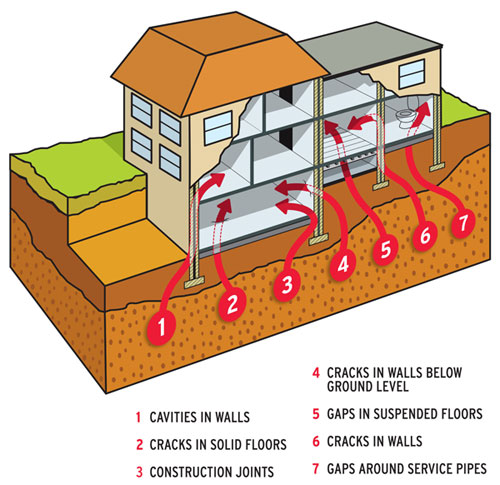Householders
Acceptable levels of radon in homes
My home
Radon can enter your home from the ground through small cracks in floors and through gaps around pipes or cables. Radon gas can be sucked from the ground into a home because the indoor air pressure is usually slightly lower than outside. The reason for this is that warmer indoor air rises, resulting in slightly lower pressure indoors.

Please watch our video to see how easy it is to test your home for radon.
Acceptable level of radon in my home
The Reference Level for homes in Ireland is 200 becquerels per cubic metre (Bq/m3). If you test your home for radon and it is above 200 Bq/m3, you should reduce the levels. The average radon level in Irish homes is 77 Bq/m3.
How likely is my home to have radon levels above 200 Bq/m3?
Homes in some parts of the country are more likely to have a radon problem. These parts of the country are called High Radon Areas. You can check our interactive map to see whether your home or workplace is in a High Radon Area. The only way to know how much radon is in your home is to take the radon test.
Rented homes
I rent my home. Does my landlord have a responsibility to test the home?
At present, there is no requirement for private landlords to test their rented homes for radon or to reduce radon if the levels are high. If you rent your home from a Local Authority or Housing Association, you should contact your landlord for information about testing your home for radon.
I am a landlord. What should I do?
The EPA recommends that all homes should be tested for radon to ensure that people living in the home are not exposed to high levels of the radioactive gas radon. If the levels are above the Reference Level of 200 Bq/m3, work should be carried out to reduce radon to below 200 Bq/m3.
At present, this is a strong recommendation; however, there is no requirement for a landlord to test for radon in rented accommodation or to reduce radon levels where they are above the Reference Level of 200 Bq/m3 for homes.
Radon in water
Radon is soluble in water and can be a problem in some groundwater supplies.
If your water comes from a surface water supply, then the radon levels are usually very low. Drinking water with high levels of radon can result in exposure of the stomach to an increased radiation dose. However, no increase in the risk of developing stomach cancer has been linked with drinking water with high levels of radon. You can also be exposed by inhaling radon gas as it is released from your drinking water. Radon in water can be easily released from water into the atmosphere when the water is agitated or heated.
Is my drinking water at risk?
If your drinking water is supplied from a borehole or private groundwater supply, then your water may be at risk of having elevated levels of radon. If you are connected to the mains supply and you get your water from a surface water supply (water from a river or a lake), the risk that your water contains elevated levels of radon is very low. This is because radon is easily dispersed from water when it is agitated as it goes through the mains system, or when left to stand for some time, in a tank or reservoir.
Testing my water
If you use water from a borehole or private groundwater supply, then we recommend that you have the levels of radon in your drinking water tested.
For public water supplies, where radon levels are found to be above 500 Bq/l, remediation of the water supply to reduce radon levels should be carried out. For private water supplies, where radon levels are found to be above 500 Bq/l, remediation of the water supply to reduce radon levels should be considered.
Reducing radon levels in drinking water
There are two water treatment methods for the removal of radon from water. Both methods are capable of reducing the radon level by more than 95 per cent.
- Aeration. This is based on the natural tendency of radon to diffuse out of water into the air. Aeration systems include multi-staged bubble aeration, high pressure air injection, and spray aeration. Adequate ventilation is then required to prevent the build-up of radon in the air.
- Granular Activated Carbon Absorption. Water is pumped through a bed of granular activated carbon which absorbs the radon. This system has the disadvantage that radioactivity can build up in the unit, which may require specialist disposal
Contact us
FreePhone: 1800 300 600
Email: radon@epa.ie